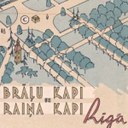0169 Nationale Folklore und politischer Totenkult
Der Brüderfriedhof in Riga (1924-1936)
Identifiers (Article)
Identifiers (Files)
Abstract
This article discusses symbolic forms and the association of folklore and politics in the Riga Brethren Cemetery (Brāļu Kapi). The iconographic and formal analysis of this memorial sheds light on its function as a place of worship for those who fell in action while fighting for the sovereignty of the Latvian people. Considering that Latvia suffered severely from different foreign rules over the past centuries, the memorial has contributed to strengthen nationalistic movements in Latvian society and has played an important role in nation-building. The cemetery’s landscape design as well as its large-scale monuments by the Latvian sculptor Kārlis Zāle (1888-1942) borrowed their themes from Latvian mythology. After investigating another major work of Zāle, the Freedom Monument in Riga, I analyse the main elements of the sculptural ensemble of the Brethren Cemetery. Eventually, I outline how the political circumstances have influenced the burial practices over the decades. With Latvia celebrating the centennial of its first proclamation of independence in 2018, the restoration of this memorial has been undertaken in recent years.
Statistics


License

This work is licensed under a Creative Commons Attribution-NonCommercial-NoDerivatives 4.0 International License.



